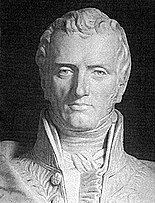A | B | C | D | E | F | G | H | CH | I | J | K | L | M | N | O | P | Q | R | S | T | U | V | W | X | Y | Z | 0 | 1 | 2 | 3 | 4 | 5 | 6 | 7 | 8 | 9
| Part of a series on |
| Continuum mechanics |
|---|
The Navier–Stokes equations (/nævˈjeɪ stoʊks/ nav-YAY STOHKS) are partial differential equations which describe the motion of viscous fluid substances. They were named after French engineer and physicist Claude-Louis Navier and the Irish physicist and mathematician George Gabriel Stokes. They were developed over several decades of progressively building the theories, from 1822 (Navier) to 1842–1850 (Stokes).
The Navier–Stokes equations mathematically express momentum balance and conservation of mass for Newtonian fluids. They are sometimes accompanied by an equation of state relating pressure, temperature and density.[1] They arise from applying Isaac Newton's second law to fluid motion, together with the assumption that the stress in the fluid is the sum of a diffusing viscous term (proportional to the gradient of velocity) and a pressure term—hence describing viscous flow. The difference between them and the closely related Euler equations is that Navier–Stokes equations take viscosity into account while the Euler equations model only inviscid flow. As a result, the Navier–Stokes are a parabolic equation and therefore have better analytic properties, at the expense of having less mathematical structure (e.g. they are never completely integrable).
The Navier–Stokes equations are useful because they describe the physics of many phenomena of scientific and engineering interest. They may be used to model the weather, ocean currents, water flow in a pipe and air flow around a wing. The Navier–Stokes equations, in their full and simplified forms, help with the design of aircraft and cars, the study of blood flow, the design of power stations, the analysis of pollution, and many other problems. Coupled with Maxwell's equations, they can be used to model and study magnetohydrodynamics.
The Navier–Stokes equations are also of great interest in a purely mathematical sense. Despite their wide range of practical uses, it has not yet been proven whether smooth solutions always exist in three dimensions—i.e., whether they are infinitely differentiable (or even just bounded) at all points in the domain. This is called the Navier–Stokes existence and smoothness problem. The Clay Mathematics Institute has called this one of the seven most important open problems in mathematics and has offered a US$1 million prize for a solution or a counterexample.[2][3]
Flow velocity
The solution of the equations is a flow velocity. It is a vector field—to every point in a fluid, at any moment in a time interval, it gives a vector whose direction and magnitude are those of the velocity of the fluid at that point in space and at that moment in time. It is usually studied in three spatial dimensions and one time dimension, although two (spatial) dimensional and steady-state cases are often used as models, and higher-dimensional analogues are studied in both pure and applied mathematics. Once the velocity field is calculated, other quantities of interest such as pressure or temperature may be found using dynamical equations and relations. This is different from what one normally sees in classical mechanics, where solutions are typically trajectories of position of a particle or deflection of a continuum. Studying velocity instead of position makes more sense for a fluid, although for visualization purposes one can compute various trajectories. In particular, the streamlines of a vector field, interpreted as flow velocity, are the paths along which a massless fluid particle would travel. These paths are the integral curves whose derivative at each point is equal to the vector field, and they can represent visually the behavior of the vector field at a point in time.
General continuum equations
The Navier–Stokes momentum equation can be derived as a particular form of the Cauchy momentum equation, whose general convective form is
where
- is the material derivative, defined as ,
- is the (mass) density,
- is the flow velocity,
- is the divergence,
- is the pressure,
- is time,
- is the deviatoric stress tensor, which has order 2,
- represents body accelerations acting on the continuum, for example gravity, inertial accelerations, electrostatic accelerations, and so on.
In this form, it is apparent that in the assumption of an inviscid fluid – no deviatoric stress – Cauchy equations reduce to the Euler equations.
Assuming conservation of mass, with the known properties of divergence and gradient we can use the mass continuity equation, which represents the mass per unit volume of a homogenous fluid with respect to space and time (i.e., material derivative ) of any finite volume (V) to represent the change of velocity in fluid media:
Text je dostupný za podmienok Creative
Commons Attribution/Share-Alike License 3.0 Unported; prípadne za ďalších
podmienok.
Podrobnejšie informácie nájdete na stránke Podmienky
použitia.


















